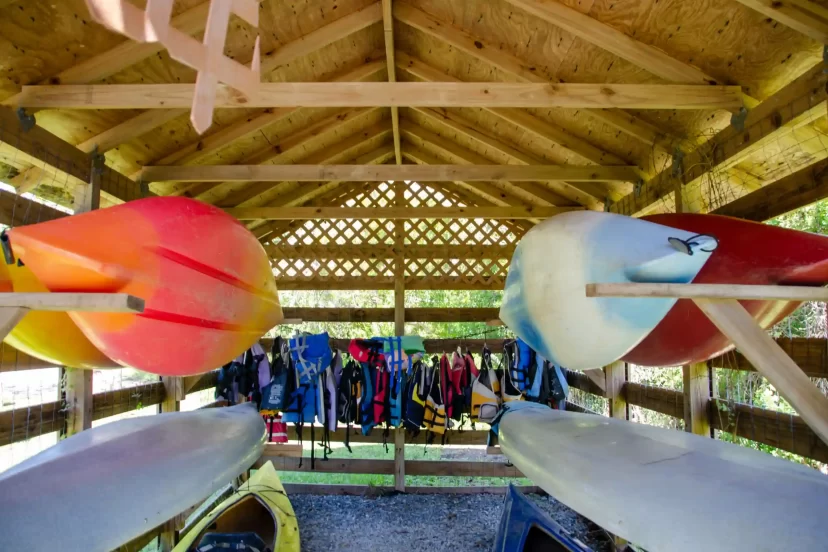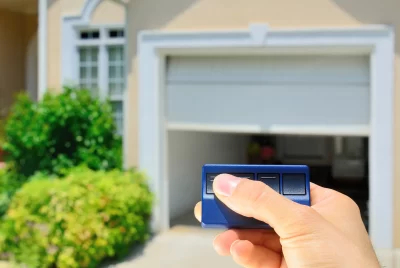Kayak Garage Storage Ideas: Organize & Protect Your Gear
Kayaking is a great way to explore nature and get some exercise, but storing kayaks can be a challenge. Proper storage not only keeps your kayak safe, but also helps it last longer. In addition, efficient storage can help you maximize space in your garage or storage area.
As we know, kayaks are long and bulky items that can take up a lot of space. So finding an area to store you kayak(s) in a safe manner will go a long way in avoiding scratches, dents, warping or even cracking the hull.
I’ve long fantasized about owning my own kayak. The vision of going off to some lake nearby anytime I wanted and enjoy some quiet time. I’ve shopped around town and dreamed of the perfect kayak for me! So this blog kind of incorporates all the ways I thought of to store one of these beauties.
Kayak Garage Storage Ideas: An Overview
As I’ve discovered, there are many different options available when it comes to storing your kayak in your garage. From wall-mounted racks, ceiling systems ideal for single-car garages where floor space is limited or freestanding racks suitable for larger garages with high ceilings – there’s an option available for every homeowner.
In addition, some people prefer hangers or straps while others opt for covers depending on their needs and preferences. We’ll try our best to cover all these options in-depth along with tips on how best to setup your kayak storage system. We’ll provide various kayak garage storage ideas that are easy to install and won’t require a professional’s expertise.
Lets get started!
Wall-mounted Kayak Racks
Wall-mounted kayak racks are great storage ideas for those who want to maximize their garage space while keeping their kayaks safe and secure. Two of the biggest advantages of wall-mounted racks are that they keep your kayaks off the ground, and can be mounted at any height you prefer providing easy access to your kayaks.
Instead of having to move multiple kayaks around in order to get the one you want, you can simply unhook it from the rack and be on your way.
2 Types of Wall-Mounted Racks
J-hooks

J-hooks are simple hooks that attach directly to the wall. They’re designed to hold the kayak by its scupper holes or handles, which makes them a great option for sit-on-top kayaks.
These are very affordable and easy to install, but they may not provide as much support as other options.
Vertical racks

These hold your kayak upright against the wall using straps or bungee cords. They take up less horizontal space than J-hooks or cradles, making them a great option for small garages.
Vertical racks are also a good choice if you have limited headroom since they keep your kayak off the ground and out of the way. Keep in mind that vertical racks can be more difficult to install than other options, so you may want to enlist the help of a friend.
Ceiling Storage Systems
An advantage of using ceiling storage systems is that they don’t take up any floor or wall space. It means you can park your car or store other gear underneath them. Ceiling storage systems also help keep your kayak out of harm’s way by preventing it from being accidentally bumped or knocked over.
Pulley/Hoist systems

A popular option that allows you to lower and raise your kayak with ease using a rope and pulley system. These systems are relatively inexpensive and easy to install but do require some manual effort.
Freestanding Kayak Racks
Freestanding kayak racks are a popular choice for those who want to store their kayaks without having to drill holes into their walls or ceilings. The main benefit is that they can be moved around easily. This means that you can change the layout of your garage whenever you need to without having to worry about removing any pulleys, motors or wall mounts first.
The main drawbacks however are that they do take up a lot of space on the floor and may not be as stable as the other options. They could potentially tip over if not properly secured.
The 2 Types of freestanding racks
Tripod Stands
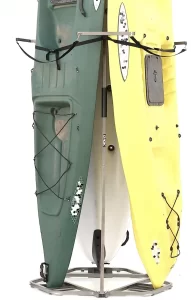
Consist of three legs that extend outward from a central point. They often come with padding on each leg, ensuring that your kayak won’t be scratched or damaged while it’s being stored.
Tripod stands are great for those who want a sturdy, yet easily movable option.
Floor Racks
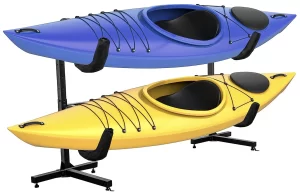
They consist of two vertical posts connected by horizontal bars where the kayaks rest. Floor racks tend to take up more space than tripod stands but offer additional stability due to their wider base.
Storage Considerations: Sea vs River Kayaks
For a sea Kayak, due to its length and design, wall mounts or free-standing racks are often the best solutions. Wall mounts make efficient use of vertical space and can support the weight of these robust kayaks. However, the mount must be sufficiently sturdy to handle the kayak’s length and weight. Free-standing racks can also be a good choice as they can often accommodate multiple or larger kayaks and don’t require any installation into walls or ceilings, making them versatile and portable.
On the other hand, River Kayaks, which are generally shorter and wider, may be better suited to ceiling mounts or pulley systems. Ceiling mounts can hold these shorter kayaks snugly against the ceiling, keeping them out of the way without using up wall or floor space. Pulley systems, with their easy-to-lift and lower mechanics, can also be a practical solution. They save on floor and wall space and can make accessing your kayak easier.
These are general guidelines for kayak garage storage ideas and a solution ultimately depends on the specifics of your garage and personal preferences. Factors like garage size, ceiling height, and the number of kayaks to be stored should be taken into consideration.
Pros and Cons of each storage type
| Type | Pros | Cons |
| Wall Mounts | Saves floor space, easy to install, often adjustable | Weight limit restrictions, will require drilling into walls |
| Ceiling Mounts | Maximizes garage space, keeps kayak out of the way | Difficult installation, height might be an issue, may require a ladder for access |
| Pulley Systems | Easy to lift and lower, saves floor and wall space | Requires installation, may be difficult to operate for some, potential for mechanical failures |
| Free-Standing Racks | Portable, doesn’t require installation into walls or ceiling, can often hold multiple kayaks | Takes up floor space, can be costly, may not hold heavier kayaks |
Please note that the right system depends on the specific needs and circumstances, including the garage size, kayak size and weight, budget, and personal preferences.
Kayak Covers
The benefits of investing in a good quality kayak cover are many. Firstly, it will protect your kayak from environmental elements such as water, wind and sun which can cause wear and tear on your kayak material over time.
Secondly, it will maintain the appearance of your kayak for longer by keeping it clean from dirt and debris.
And lastly, if you plan to store your kayak outdoors or transport it on top of your car or truck regularly, having a cover will help prevent scratches or damages.
Types of Kayak Covers
Outdoor Covers:
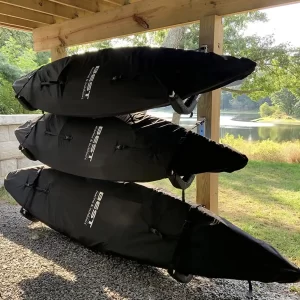
If you plan on storing your kayaks outside all year round, instead of your garage, then choosing an outdoor cover is a good idea. Outdoor covers are usually designed with heavy-duty materials. I would assume if you’re keeping your kayak outside then you have a safe and secure place to put it.
Storage Covers:

These are ideal if you’re planning to store your kayaks inside or in an enclosed space for long periods like during winter or off-seasons. They come in lighter materials compared to outdoor covers which make them easy to handle while still providing enough protection against dust, insects or other small animals.
Quick Tips for Organizing Kayaks in a Garage
How to maximize space in your garage
If you want to make sure that your kayaks don’t take up too much room in the garage, start by taking an inventory of everything else that’s in there. Chances are, you’ll find plenty of items that can be donated or thrown away.
Once you’ve decluttered your space, try these tricks for maximizing storage:
- Invest in shelving: Installing shelves on the walls or above doors gives you more room to store gear away from your kayak.
- Hang paddles on the wall: Mounting paddles vertically saves floor space while keeping them organized and accessible.
- Make use of corners: Corner shelving units take up very little space and provide ample storage for other items.
- Use hooks to hang your life vests and waterproof bags and helmets so they can dry off after a trip out.
How to keep kayaks safe from damage
Here are some tips for keeping your boats safe:
- Clean before storing: Always rinse off salt water or debris before storing kayaks.
- Add padding: Foam blocks or pool noodles can be used to add extra cushioning where needed.
- Avoid stacking boats: If possible, store each kayak separately so they don’t rub against each other.
- Keep them off the ground: Using a rack or lift system to keep your kayaks elevated can prevent damage from moisture or pests.
FAQ
- What is the most cost-effective storage option for my kayak?
J-hooks and rope hangers are generally the most affordable options for kayak garage storage ideas. - How do I protect my kayak from potential theft during storage?
Secure your kayak using a lock and cable. If stored outside, keep it out of sight or use a kayak alarm system. - How do I prevent my freestanding rack from tipping over?
Ensure even weight distribution and consider anchoring the rack to the floor for added stability. - What factors should I consider when deciding the height of my wall-mounted rack?
Consider the kayak’s weight, your own height, and lifting abilities. Ensure easy accessibility without straining. - Does the orientation of the kayak on the rack matter?
Yes, storing the kayak on its side or upside down can prevent deformation of the hull over time. - What precautions can I take to avoid scratches and dents on my kayak during storage?
Use padded racks and straps, clean the kayak before storage, and avoid stacking kayaks on each other. - Is it necessary to cover my kayak if I’m storing it indoors?
While not necessary, a cover can prevent dust accumulation and protect from possible indoor elements. - What if I need to store my kayak temporarily at a non-residential place, like a vacation spot?
Temporary storage solutions could include portable stands, inflatable racks, or even secure kayak carts. - How do I safely store my kayak’s accessories in the garage?
Use hooks, shelves, and bins to store paddles, life vests, and other accessories neatly and safely. - What is the best way to clean my kayak before storage?
Rinse with fresh water, dry completely, and consider using a UV protectant spray for extended storage periods.

